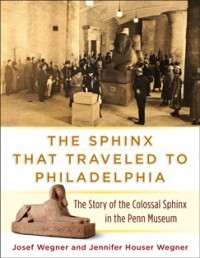
With dozens of newspaper stories covering the excitement of the sphinx's arrival, thousands of Philadelphians and visitors from out of town came to see the sphinx. For three years the sphinx resided outside in the Museum's courtyard. In 1916, due to concern over the long-term effects of the weather, the sphinx moved inside the Museum. In 1926 it made its final move into the Coxe Egyptian wing of the Museum where it sits today amongst other magnificent monuments also from ancient Memphis. These include architectural elements such as columns, doorways and windows from the palace of pharaoh Merenptah, son of Ramses II, which the Museum's Coxe Expedition to Egypt excavated at Memphis in 1915-1919.
The Penn Museum sphinx is in many ways the quintessential sphinx. Although its body is perfectly preserved, the head and face was weathered over thousands of years. Its timeworn countenance embodies the mystique of ancient Egypt. Ever since the sphinx first arrived in Philadelphia people have liked to envision what "old Ramses the Great" might have to say about our modern world. In 1913 people wrote articles and even poetry giving the sphinx a voice on matters of the day. A century later in 2013, school children have sleepovers, "40 Winks with Sphinx," under the watchful eyes of the big human-headed lion. The sphinx of Ramses II is a treasured icon of Philadelphia and the Penn Museum. The sphinx is the largest Egyptian sphinx in the Western hemisphere and fourth largest sphinx outside of Egypt (other colossal sphinxes can be found in Paris, France and St. Petersburg, Russia). It has charmed generations of visitors to the Museum and now has spent a full a century as a citizen of Philadelphia. Certainly a milestone, although a blink of the eye in the lifetime of an Egyptian sphinx!
Written to celebrate the centennial of the Sphinx's arrival in Philadelphia, The Sphinx That Traveled to Philadelphia tells the fascinating story of the colossal sphinx that is a highlight of the Penn Museum's Egyptian galleries and an iconic object for the Museum as a whole. The narrative covers the original excavations and archaeological history of the Sphinx, how it came to Philadelphia, and the unexpected ways in which the Sphinx's story intersects with the history of Philadelphia, the University of Pennsylvania, and the Museum just before World War I.
The book features ample illustrations—photographs, letters, newspaper stories, postcards, maps, and drawings—drawn largely from the extensive materials in the Museum Archives. Images of related artifacts in the Penn Museum's Egyptian collection and other objects from the Egyptian, Near East, and Mediterranean Sections (many not on view and some never before published), as well as pieces in museums in the United States, Europe, and Egypt, place the story of the Penn Museum Sphinx in a wider context. The writing style is informal and text is woven around the graphics that form the backbone of the narrative. The book is designed to be of interest to a wide audience of adult readers but accessible and engaging to younger readers as well.
The full tale of the journey of the Penn Museum sphinx from Egypt to Philadelphia, detailing its discovery, voyages by sea and river, publicity for the general public and even the sphinx at the world series. Everything that one might wish to know about this iconic monument and its fame across continents can be found here.

